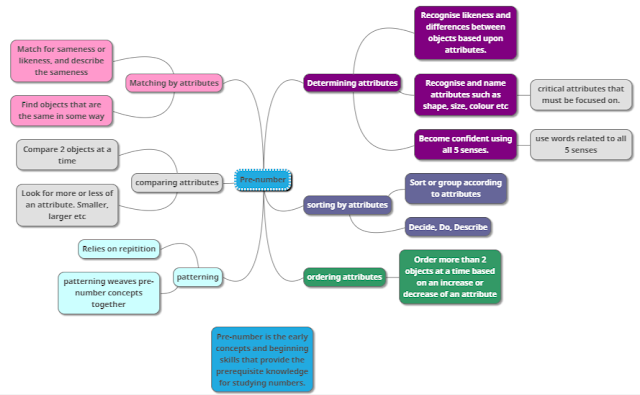Pre-number and early number concepts:
The big ideas:
This week's lecture and tutorial discussed pre-number and early number concepts. Children begin to develop an understanding of number before reaching school age through their parents, and experiences in life. Reys et al., (2020) states that some characteristics of early number concepts are:
- Understanding of quantities and patterns
- Estimation
- Expectation that numbers are useful.
The 5 counting principles are vital to understanding successful counting.
NCII. (2016, October 13). Reviewing five counting principles [Video] YouTube. https://www.youtube.com/watch?v=SG0jzpZtfgs
3 types of numbers:
1 - counting (how many) cardinal numbers
2 - quantity (how much)
3 - position (who is 1st, 2nd) ordinal numbers
4 - number as a label (door numbers, student number) nominal
Mathematics is fun. (2014, December 23). Cardinal, ordinal and nominal numbers [Video] YouTube. https://www.youtube.com/watch?v=A-mo5svIPbg
Student language
|
Material Language
|
Mathematical language
|
Symbolic Language
| |
Language
|
Find one that is the same (shape, size, colour)
|
Can you describe the sameness? Are they the same shape, size, colour
|
Match, match by size, match by colour
| |
Materials
|
Familiar objects, toys, dolls, snacks, books
|
Substituted objects, blocks
|
Substituted objects, photos,
graphics, diagrams
| |
Recording
|
Drawings
|
Drawings
|
Drawing different sizes and colours
|
Personal reflection:
I already had an understanding that children's introduction to numbers begins in the home, but the ability to match according to attributes was an important concept for me to learn. Ensuring that the 5 counting principles are consolidated to successfully count is also new, and something I will focus on when teaching.
Concept, skills and strategies:
The concept of subitizing refers to how children develop a picture in their head for numbers without having to count. The use of patterns, such as the Caldwell pattern is used to teach this.
Homemade Caldwell pattern cards.
A possible misconception:
Some students may be able to subitise small collections (XXX) but cannot subitise (XXXX) as they cannot count yet, or haven't made the connection between spoken numbers and the visual. This is where formal instruction of the cardinal principle will be required (Farrell, 2011).
ACARA:
Subitising: Foundation year / Number and Algebra / Number and place value / ACMNA003)
Elaboration:
- Use subitising as the basis for ordering and comparing collections of numbers
Scootle resource: reSolve: Counting: Handfuls https://www.resolve.edu.au/counting-handfuls
This lesson builds students counting skills, particularly their ability to subitise a collection.
Resources:
This book demonstrates ordinal numbers in a real-life situation, would suit all stages of the language model.
Gilley. (2018, August 13). Ordinal numbers Henry the fourth read aloud [Video] YouTube. https://www.youtube.com/watch?v=SVEHVWLQPyc&t=57s
Additional resources:
Word Count: 283

